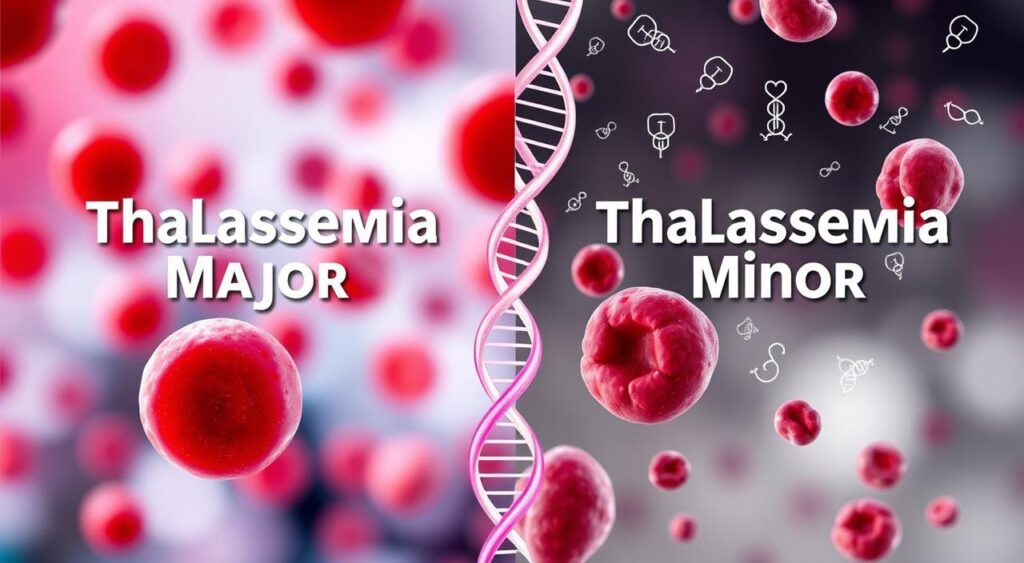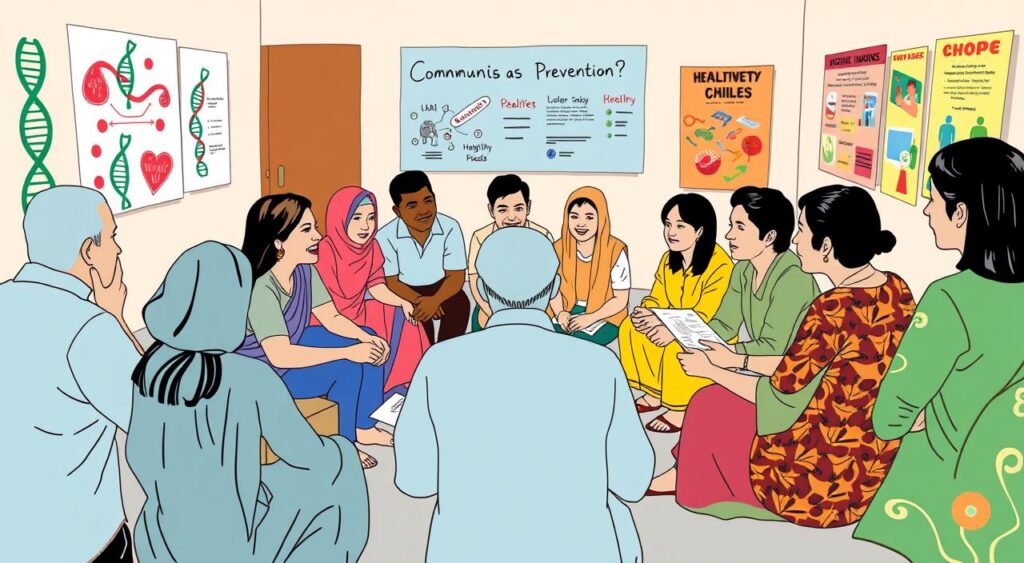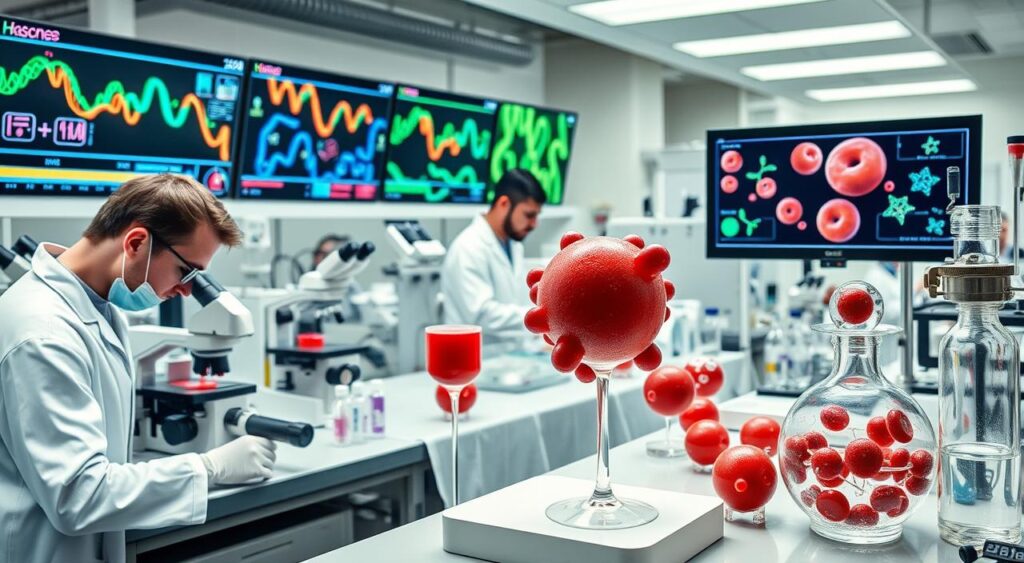Explore the key differences between Thalassemia Major and Thalassemia Minor (Trait), two genetic blood conditions. Discover the unique symptoms, causes, and treatment approaches for each.
Thalassemia is a genetic disorder that affects how red blood cells carry oxygen. Knowing the difference between thalassemia major and minor is key. This is because they have different causes, symptoms, and treatments.

Key Takeaways
- Thalassemia major is a severe form of the disorder that requires regular blood transfusions.
- Thalassemia minor, also known as thalassemia trait, is a milder form that may not require treatment.
- Thalassemia major and thalassemia minor have distinct causes, symptoms, and treatment options.
- Understanding the difference between thalassemia major and thalassemia minor is crucial for effective management and treatment.
- Thalassemia major and thalassemia minor are genetic blood disorders that affect the production of hemoglobin.
- Thalassemia major and thalassemia minor can have a significant impact on a person’s quality of life if left untreated or poorly managed.
Understanding Thalassemia Major and Thalassemia Minor (Trait)
Thalassemia is a thalassemia genetic disorder that affects how red blood cells carry oxygen. It’s important to know the difference between thalassemia major and minor. This helps us understand how it affects the body.
The disorder happens because of a problem with the HBB gene. This gene is crucial for making hemoglobin. The symptoms of thalassemia can vary, from mild to severe. Getting an accurate thalassemia diagnosis is key to managing the condition.
Definition of Thalassemia
Thalassemia is a genetic disorder that affects hemoglobin production. This leads to anemia and other issues. The severity of thalassemia depends on the type and the extent of the mutation.
Basic Differences Between Major and Minor Forms
Thalassemia major is a more severe form that requires regular blood transfusions. Thalassemia minor is milder and often needs little treatment. The severity of symptoms is the main difference between the two.
Genetic Inheritance Patterns
Thalassemia is inherited in an autosomal recessive pattern. This means a person needs two copies of the mutated gene to have the condition. Knowing this helps with thalassemia diagnosis and genetic counseling for families.
The Genetic Basis of Thalassemia
Thalassemia is a thalassemia genetic disorder that affects how red blood cells carry oxygen. It happens because of changes in the HBB gene. This gene tells our bodies how to make a part of hemoglobin.
These changes can make our bodies not make enough or any of this part. This leads to a thalassemia blood disorder.
The genetics of thalassemia are quite complex. Several genetic changes play a role in it. Some key factors include:
- Mutations in the HBB gene
- Deletions or duplications of the beta-globin gene
- Point mutations that affect the production of the beta-globin subunit
Knowing how thalassemia is caused is very important. It helps doctors find the best ways to treat and manage it. By understanding the genetic changes, doctors can give more tailored care to those with this thalassemia genetic disorder.
Symptoms of Thalassemia Major
Thalassemia major is a serious form of thalassemia. It causes thalassemia symptoms like severe anemia, fatigue, and shortness of breath. Without treatment, it can lead to heart failure and bone deformities. It’s important to diagnose and treat it early to avoid serious problems.
Early Warning Signs
Early signs of thalassemia major include pale skin, weakness, and shortness of breath. Children with it might also grow and develop slower.
Severe Complications
Thalassemia major can cause heart failure, bone deformities, and a higher risk of infections. Thalassemia treatment like blood transfusions and iron chelation therapy can help manage these issues.
Impact on Child Development
Thalassemia major can slow down a child’s growth and development. It also increases the risk of infections. Early diagnosis and thalassemia treatment can help reduce these effects and improve a child’s life quality.
Identifying Thalassemia Minor Symptoms
Thalassemia minor, or thalassemia trait, is a mild form of thalassemia. It might not show any symptoms. But, it can lead to iron overload and other issues. People with it might have mild anemia, which blood tests can spot.
It’s key to get regular check-ups to avoid long-term problems. Symptoms of thalassemia minor include:
- Fatigue
- Weakness
- Pale skin
- Shortness of breath
Thalassemia minor can also raise the risk of iron overload. This can cause serious health issues if not treated. So, those with it should get blood tests to check their iron levels often.
Some people with thalassemia minor might not show any symptoms. But, knowing the risks and taking steps to stay healthy is crucial. This helps keep overall health and well-being in check.
| Symptom | Description |
|---|---|
| Mild anemia | A condition characterized by a decrease in red blood cells or hemoglobin |
| Fatigue | A feeling of tiredness or weakness |
| Iron overload | A condition where the body accumulates excess iron, leading to potential health problems |
Diagnosis Methods and Testing
Diagnosing thalassemia involves several steps. Blood tests check for abnormal hemoglobin levels, a sign of thalassemia. Genetic testing finds the mutations that cause the disorder. This helps in early diagnosis and prevention.
Here are the main methods for diagnosing thalassemia:
- Blood tests to detect abnormal hemoglobin levels
- Thalassemia genetic testing to identify mutations
- Prenatal screening to detect the disorder in unborn babies
Early diagnosis is key for managing thalassemia. Genetic testing can also spot carriers. This knowledge helps in planning families.
Seeing a healthcare professional is crucial for diagnosis and treatment. They guide on the best steps and help through the process. With proper care, people with thalassemia can live healthy lives.
| Diagnosis Method | Description |
|---|---|
| Blood Tests | Detect abnormal hemoglobin levels |
| Thalassemia Genetic Testing | Identify mutations that cause the disorder |
| Prenatal Screening | Detect the disorder in unborn babies |
Treatment Approaches for Thalassemia Major
Thalassemia major needs regular blood transfusions to replace damaged red blood cells. This is key to treating thalassemia, as it helps reduce symptoms and improve life quality. Besides blood transfusions, iron chelation therapy is used to remove excess iron. This helps prevent long-term problems.
Managing thalassemia also means regular check-ups and monitoring. This helps prevent complications and ensures the best results. This care includes:
- Regular blood tests to check iron levels and blood cell counts
- Annual visits with a healthcare provider to monitor health and adjust treatment
- Lifestyle changes, like a healthy diet and exercise, to manage symptoms and improve health

By sticking to a detailed treatment plan, patients with thalassemia major can manage their symptoms. They can also prevent complications and improve their life quality. It’s crucial to work closely with a healthcare provider. This way, a treatment plan can be made that fits the individual’s needs and situation.
Managing Thalassemia Minor
Thalassemia minor can be managed with lifestyle changes and diet tips. Regular health checks help avoid serious problems. It’s important to avoid iron supplements and eat well.
Here are some tips for thalassemia prevention and management:
- Avoid too much iron
- Eat a balanced diet
- Drink plenty of water
- Go for regular health checks
By sticking to these tips and consulting a doctor, people with thalassemia minor can lower their risk of complications.
| Lifestyle Modification | Dietary Recommendation |
|---|---|
| Avoid excessive iron intake | Maintain a balanced diet |
| Stay hydrated | Limit iron supplements |
Blood Transfusion Protocols
For those with thalassemia major, thalassemia blood transfusion is key. It replaces damaged red blood cells. This reduces risks and boosts health. The amount and how often you get transfusions depend on your health and how you react to treatment.
Good thalassemia treatment means more than just transfusions. It also includes watching your health closely and regular check-ups. This helps avoid serious problems and aims for the best health outcomes. Important parts of blood transfusion care include:
- Regular transfusions to keep red blood cell levels healthy
- Checking iron levels to avoid too much
- Follow-up care for any issues that might come up
By sticking to these plans and teaming up with doctors, people with thalassemia can manage their condition well. This improves their life quality.
| Transfusion Frequency | Transfusion Dosage | Monitoring |
|---|---|---|
| Every 2-4 weeks | Depends on individual needs | Regular blood tests and iron level checks |
Complications and Long-term Effects
Thalassemia can cause heart failure, bone deformities, and iron overload. These are thalassemia complications. It’s important to get regular check-ups to avoid these problems. People with thalassemia might also face organ damage and growth issues.
Thalassemia can affect a person’s health a lot. Some possible issues include:
- Heart problems, such as heart failure and arrhythmias
- Bone deformities, including stunted growth and osteoporosis
- Iron overload, which can damage organs like the liver and heart
People with thalassemia might also deal with emotional and social challenges. These can include anxiety and depression. It’s important to get help through counseling and support to stay well.
Physical Health Impact
Regular blood transfusions and iron chelation therapy can help manage thalassemia complications. But, it’s key to know the risks and take steps to avoid them.
Emotional and Social Challenges
Living with thalassemia can be tough, but with the right support, people can live full lives. It’s crucial to focus on emotional and social well-being, along with physical health, for a good quality of life.
Prevention Strategies and Genetic Counseling
Preventing thalassemia is key to stopping it from being passed on to future generations. Genetic counseling is very important here. It helps people with a family history of thalassemia know their risk. Through thalassemia genetic counseling, they can make smart choices about having kids and prevent the disorder from being passed on.
Some important ways to prevent thalassemia include:
- Prenatal screening and genetic testing to find the disorder before birth
- Genetic counseling to understand the risk of passing it on
- Family planning and reproductive options to lower the risk of passing it on
By knowing how important thalassemia prevention and thalassemia genetic counseling are, people can take steps to lower the risk. This ensures a healthy future for themselves and their families.

Prevention is key in reducing the risk of thalassemia, and genetic counseling is an essential tool in this process.
| Prevention Strategy | Description |
|---|---|
| Prenatal Screening | Identify the disorder in utero through genetic testing |
| Genetic Counseling | Understand the risk of transmitting the disorder and make informed decisions |
| Family Planning | Reduce the risk of transmission through reproductive options |
Living with Thalassemia: Daily Management Tips
Managing thalassemia well is key for those with the condition. By following daily tips, people can lower risks and live better lives.
Managing thalassemia daily means making lifestyle changes, getting medical care, and having emotional support. Regular exercise, a healthy diet, and managing stress are all helpful.
Exercise Guidelines
Exercise is important for staying healthy and avoiding problems. Here are some tips for exercising with thalassemia:
- Avoid hard activities that make you tired or breathless
- Try low-impact exercises like yoga or swimming to stay flexible and strong
- Talk to a doctor to create a workout plan just for you
Nutrition Plans
Eating right is crucial for health and managing thalassemia. Here are some nutrition tips:
- Eat lots of fruits, veggies, and whole grains
- Stay away from foods high in iron, like red meat and some cereals
- Get help from a dietitian to make a meal plan that fits you
Mental Health Support
It’s important to take care of your mental health with thalassemia. Here are ways to get support:
- See a therapist or counselor
- Join a group for thalassemia patients
- Try stress-reducing activities like meditation or deep breathing
By using these tips, you can manage your thalassemia and feel better overall.
Latest Research and Medical Advances
Thalassemia research has made big strides in medical advances. New treatments like gene therapy and stem cell transplantation are being developed. These aim to improve life quality for those with thalassemia.
Some key areas of thalassemia research include:
- Gene therapy: This uses genes to treat or prevent thalassemia.
- Stem cell transplantation: This replaces damaged stem cells with healthy ones to make normal red blood cells.
- Other emerging therapies: Researchers are also looking into RNA-based therapies and small molecule therapies.
These advances could change how we treat thalassemia, offering new hope. Ongoing research is vital to understanding the disease better and finding effective treatments.

As research keeps moving forward, it’s important to stay updated. This ensures the best care for those with thalassemia.
Support Resources and Organizations
People with thalassemia can find help in thalassemia support groups and organizations. The Thalassemia Foundation and the Cooley’s Anemia Foundation are key thalassemia organizations. They offer educational materials, advocacy, and community support.
These groups are vital in spreading the word about thalassemia and funding research. They also help people with thalassemia connect with others. This connection can be a big source of thalassemia support.
- Counseling and emotional support
- Education and awareness programs
- Advocacy and policy development
- Research funding and grants
By contacting these organizations, people with thalassemia can get a lot of help. They can find information, resources, and thalassemia support to manage their condition better.
When to Seek Medical Attention
People with thalassemia need regular check-ups to avoid serious problems. It’s very important to get thalassemia medical attention fast if there’s an emergency.
Emergency Situations
If you have severe anemia or heart failure, get help right away. These thalassemia emergency situations are very serious and need quick action.
Regular Check-up Schedule
Going for regular check-ups is key for thalassemia patients. This includes:
- Regular blood tests to check anemia and iron levels
- Annual heart exams to find heart issues early
- Regular checks on liver and kidney health
By getting thalassemia medical attention often, you can keep your condition under control. This helps avoid serious problems later on.

Conclusion
Thalassemia is a genetic blood disorder that needs quick diagnosis and treatment to avoid serious problems. Knowing the difference between thalassemia major and minor is key for good care. An early thalassemia conclusion is that catching it early and acting fast greatly improves life for those with it.
We talked about what thalassemia is, its symptoms, how to diagnose it, and how to treat it. We stressed the importance of getting medical help and sticking to a treatment plan. A thalassemia summary shows we need a full plan to tackle the physical, emotional, and social issues of thalassemia.
Our goal is to spread the word about thalassemia and push people to manage it well. This thalassemia conclusion reminds us that with the right care, people with thalassemia can live full and happy lives. For a complete thalassemia summary, always check with trusted sources and doctors.
FAQ
Q: What is the difference between thalassemia major and thalassemia minor?
A: Thalassemia major is a severe form that needs regular blood transfusions. Thalassemia minor is milder and might not need treatment. Both are genetic blood disorders that affect hemoglobin production.
Q: What are the symptoms of thalassemia major?
A: Symptoms include severe anemia, fatigue, and shortness of breath. Without treatment, it can cause heart failure and bone deformities. Blood transfusions are key to managing it.
Q: How is thalassemia diagnosed?
A: Blood tests and genetic testing can diagnose thalassemia. These tests check for abnormal hemoglobin and genetic mutations. Early detection is vital for proper treatment.
Q: What are the treatment options for thalassemia major?
A: Treatment includes regular blood transfusions to replace damaged red blood cells. Other options are iron chelation therapy, bone marrow transplantation, and gene therapy. Regular care is crucial for managing the condition.
Q: How can thalassemia minor be managed?
A: Lifestyle changes like avoiding iron supplements and eating well can help manage thalassemia minor. Regular check-ups and a personalized plan are also important. Working with a healthcare provider is key.
Q: What are the complications of thalassemia?
A: Complications include heart failure, bone deformities, and iron overload. It can also lead to emotional and social challenges like anxiety and depression. Regular care can help manage these issues.
Q: Can thalassemia be prevented?
A: Thalassemia is genetic, so prevention is not guaranteed. Genetic counseling and prenatal screening can identify risks. Preimplantation genetic diagnosis (PGD) can also reduce the risk of passing the mutation.
Q: What are the latest research and medical advances in thalassemia?
A: New treatments like gene therapy and stem cell transplantation are being researched. These advances aim to improve health outcomes and quality of life. Ongoing research is crucial for bringing these treatments to patients.
Q: Where can I find support resources and organizations for thalassemia?
A: Organizations like the Thalassemia Foundation and the Cooley’s Anemia Foundation offer support. They provide information, resources, and support for individuals and families affected by thalassemia.
